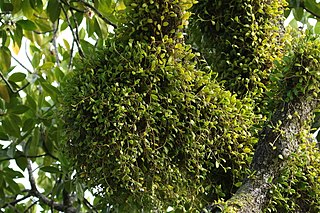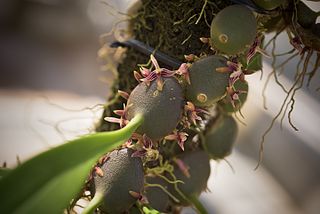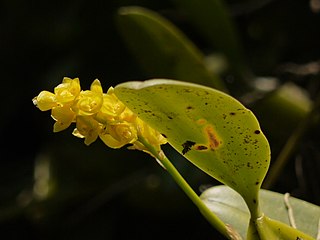
Bulbophyllum is a genus of mostly epiphytic and lithophytic orchids in the family Orchidaceae. It is the largest genus in the orchid family and one of the largest genera of flowering plants with more than 2,000 species, exceeded in number only by Astragalus. These orchids are found in diverse habitats throughout most of the warmer parts of the world including Africa, southern Asia, Latin America, the West Indies, and various islands in the Indian and Pacific Oceans. Orchids in this genus have thread-like or fibrous roots that creep over the surface of trees or rocks or hang from branches. The stem is divided into a rhizome and a pseudobulb, a feature that distinguished this genus from Dendrobium. There is usually only a single leaf at the top of the pseudobulb and from one to many flowers are arranged along an unbranched flowering stem that arises from the base of the pseudobulb. Several attempts have been made to separate Bulbophyllum into smaller genera, but most have not been accepted by the World Checklist of Selected Plant Families.

Bulbophyllum beccarii is by far the largest species in the genus Bulbophyllum and one of the largest in the orchid family.

Ansellia is considered a monotypic genus of orchid, with only one species, Ansellia africana, commonly known as African ansellia or leopard orchid, however, it may in fact be a complex group of species which share common floral structure and growth habit.

Bulbophyllum fletcherianum, the tongue orchid, Fletcher's bulbophyllum or Spies' bulbophyllum, is a rare orchid native to southern New Guinea. It prefers sunny rock outcrops or mossy tree branches, but besides being lithophytic or epiphytic, it can also be pseudo-terrestrial. The tongue orchid requires high humidity and moist roots.

Dendrobium bigibbum, commonly known as the Cooktown orchid or mauve butterfly orchid, is an epiphytic or lithophytic orchid in the family Orchidaceae. It has cylindrical pseudobulbs, each with between three and five green or purplish leaves and arching flowering stems with up to twenty, usually lilac-purple flowers. It occurs in tropical North Queensland, Australia and New Guinea.

Bulbophyllum arfakianum is a species of orchid in the genus Bulbophyllum. This rare orchid is endemic to Arfak Mountains at elevations 50~400 meters in rainforests, Papua New Guinea.

Bulbophyllum baileyi, commonly known as the fruit fly orchid, is a species of epiphytic or lithophytic orchid that is native to Queensland and New Guinea. It has coarse, creeping rhizomes, curved, yellowish pseudobulbs with a single thick, fleshy leaf, and a single cream-coloured flower with yellow, red or purple spots. It grows on trees and rocks in open forest, often in exposed places.

Bulbophyllum clandestinum is a species of orchid in the genus Bulbophyllum. This orchid grows long hanging rhizomes from which it produces tiny pseudobulbs that each bear one leaf. Flowers are born on each node, they are 3–5 cm in length and are a creamy colour. It is native to Borneo, Laos, Malaysia, Myanmar, Thailand, the Philippines, and Vietnam.

Bulbophyllum cruciatum is a species of orchid in the genus Bulbophyllum found in Papua, Papua New Guinea, Seram Island, and Maluku Islands.

Bulbophyllum exiguum, commonly known as the tiny strand orchid, is a species of epiphytic or lithophytic orchid that is endemic to eastern Australia. It has small, roughly spherical pseudobulbs each with a single leaf and up to three small creamy white to yellow flowers emerging from the base of the pseudobulb. This orchid grows in rainforest and dry forest where it often covers the branches of trees or rocks on which it grows.

Bulbophyllum lepidum, is a species of orchid, in the subfamily Epidendroideae and the genus Bulbophyllum, with the common name: Venus' fan bulbophyllum.
Bulbophyllum lichenoides is a species of orchid in the genus Bulbophyllum. This plant is non-poisonous. It is found in New Guinea on trees in range forests at elevations around 800 meters as a mini-miniature sized, warm growing epiphyte with barely noticeable, cylindrical pseudobulbs carrying a single, apical, patent, oblong, obtuse leaf that blooms in the late winter and early spring on an erect, short to 0.12" (3 mm) long, single flowered inflorescence.

Bulbophyllum longiflorum, commonly known as the pale umbrella orchid, is a species of epiphytic or lithophytic orchid. It has a creeping rhizome, widely spaced, dark green pseudobulbs with a single large, fleshy leaf, and flowers spreading in a semicircular umbel, resembling one-half of an umbrella. The flowers are canoe-shaped, greenish cream-coloured to yellowish with purple dots. It has a wide distribution and is found in parts of Africa, on islands in the Indian and Pacific Oceans, Southeast Asia, New Guinea and northern Australia.
Bulbophyllum montense is a species of orchid in the genus Bulbophyllum found in Borneo.

Bulbophyllum plumatum is a species of orchid in the genus Bulbophyllum.

Bulbophyllum retusiusculum is a species of orchid in the genus Bulbophyllum.

Bulbophyllum rosemarianum is a species of orchid in the genus Bulbophyllum.
Bulbophyllum sphaericum is a species of orchid in the genus Bulbophyllum. It is found in Sichuan and Yunnan, providence of China. The Bulbophyllum sphaericum is a warm to cool growing epiphyte with a creeping, branching rhizome with .4" [1 cm] between each globose pseudobulb carrying a single, apical, thickly leathery, elliptic-oblong, abaxially purplish red, adaxially pale green, margin slightly recurved, retuse apically, sessile base leaf that blooms in the summer on an erect, basal from the pseudobulb, much longer than the leaf, 4 to 5 flowered inflorescence holding the flowers in an apical umbel.

Bulbophyllum sect. Intervallatae is a section of the genus Bulbophyllum.

Bulbophyllum scotinochiton is a species of orchid found in Sumatra.

















